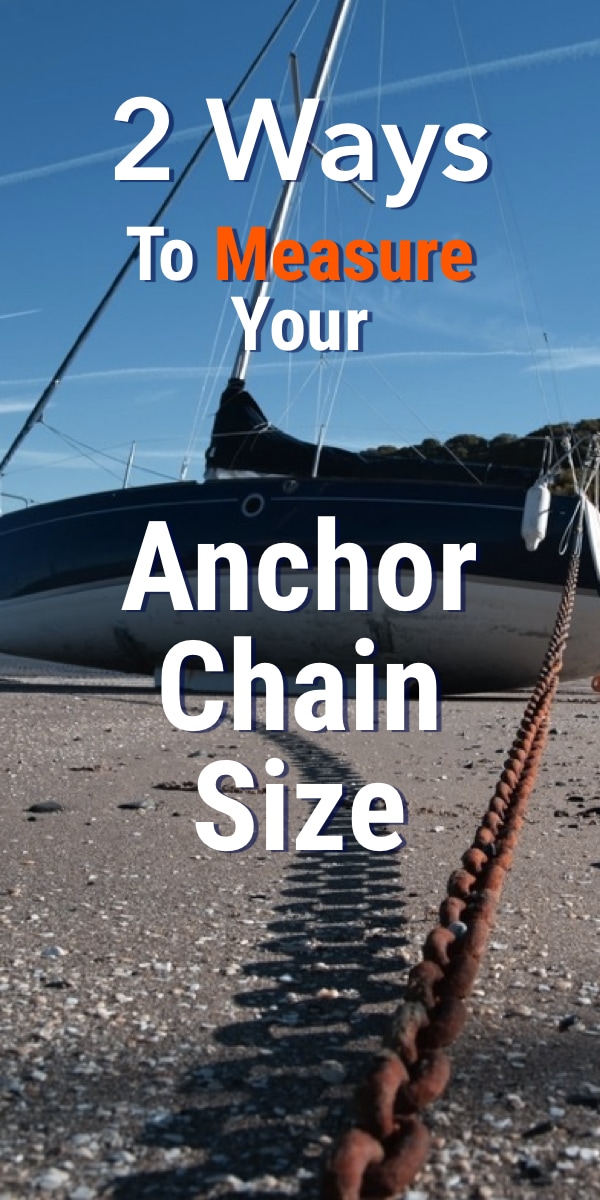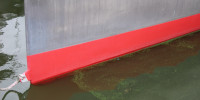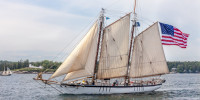How To Measure Your Anchor Chain Size (Two Ways)
Buying new anchor your chain for your boat can be more complex than it sounds. You can't just walk into a marine store and order "A hundred meters of your best." It's got to fit your boat or things won't work right. Don't worry though, there are ways to figure out what that rusty mess in your bow locker used to be, or what your new boat needs.
So how do you measure your anchor chain size? Anchor chain is measured in two primary ways - thickness of the metal in the link, and the length of the link. The most precise method is to use Vernier calipers, though with care a measuring tape can get a close enough estimate.

A chain labeled 3/8" is made from metal 3/8" diameter and shaped into links and welded. Take your calipers and close them on the link at any part away from the weld (it may be slightly thicker there) and take the measurement.
Next, measure the width of a link and the length. You can also measure the internal length and width, but those are less crucial and you can measure the outside and subtract the diameter to get an approximation.
A helpful number to have is the number of links per foot of chain. Measure one foot of the chain with a tape, then count the links.
Why So Many Measurements?
The chain rod diameter is only one critical number, but the length of chain may vary based on the purpose of the chain. Your windlass gypsy is specifically engineered to catch links of a certain dimension. If the links are the correct diameter but the length wrong, the gypsy may not catch the links to get traction on them, or the links might jam.
The gypsy is sized exactly for the chain. This size may be English or metric, and it will be specific for the chain and link size. It is possible to get gypsies in different sizes for the same windlass, so you if you can not find a replacement chain to match the gypsy on your boat now there is a solution.
We had this problem when replacing 12mm chain on our boat in the United States, where we could not get metric chain. We could get a 7/16" gypsy for our windlass, and when we replaced our chain years later in New Zealand, we went back to the original 12mm gypsy.
Getting the right chain
There are several ways to be sure you've gotten the proper chain for your windlass.
- Get a sample length of chain from your reseller to test against your gypsy. Some vendors have short lengths you can borrow, or may send you a sample piece. Just ask.
- Remove the gypsy from your windlass and bring it to your chain supplier. You can lay the actual chain into the windlass to ensure it fits.
- Most gypsies have a number inscribed on them. Find this number and contact your windlass manufacturer to get a list of suitable chain sizes.
What types of chain are available?
Common marine chains come in several styles of link and chain, high-test (HT), Triple B (BBB) and proof coil. Differences include the strength of steel and the dimensions.
- High-test may be marked HT, G4, or HT4. It is generally Grade 40 high carbon manganese alloy steel and has a higher tensile strength that other grades. Working loads for HT are about twice that of BBB and proof coil. This is popular for anchor chain because you can carry more of it. HT chain is calibrated for windlasses with a consistent link size so any chain marked HT should fit an HT gypsy for that diameter.
- Grade 70 HT is sized similarly to the links of HT, but the heat treated steel has about 20% higher working and breaking loads. It's not as common as HT because of the increased cost and lower availability, and it may not be compatible with an HT gypsy of the same size. Gold colored Grade 70 “Transport” chain is made for road use applications which made not be calibrated for a windlass and is likely not galvanized for marine use.
- Proof Coil is grade 40 low carbon steel with markings of PC, PC3 or sometimes G3. Most proof coil is not calibrated for windlass use and may bind and jam from variations in link size. The link sizes are not correct for most windlasses though it may work in some applications. Proof coil is sometimes used on rope/chain rodes on boats with no windlass.
- BBB is marked 3B or BBB and is a short link chain compared to PC or HT. It is also lower grade 30 low carbon steel. At half the strength of HT it's not as popular as it used to be though it still is on many boats. BBB is heavier per foot than GT or proof coil so it has good holding characteristics. But we can carry more length of HT for the weight.
- Stainless chain is very attractive and does not corrode like galvanized chain, but is not recommended for extensive anchoring. It has lower tensile strength than other chains, and stainless steel can be subject to anaerobic crevice corrosion if it is under water a lot. It is adequate for the occasional overnight or day hook, but those who anchor their boats for longer periods avoid it.
What Size Chain do I Need?
If you are replacing existing chain on a boat, use the measuring techniques to determine what you already have. Marks on the chain will show grade when it’s new but may be difficult or impossible to read after years of use.. Once you figure out what you have, you can decide if you want to replace the old chain with a different sort. Upgrading an older BBB or proof coil rode to HT is recommended.
You size the chain by the amount of load it will have on it. The heavier the boat, the more chain needed. This isn't a one size fits all equation as two boats with the same length may have very different weights and different amounts of windage.
Calculating the Loads on the Chain
The load on your chain is a combination of the weight of your boat, her windage, the shear of your boat (how much she moves around at anchor), and the momentary wind, scope, current, and a few other factors which are constantly changing. It's a complex calculation, and unlikely to be accurate given the range of variables across all conditions you may anchor in.
You don't need to calculate all the forces. There are a finite range of chain sizes to choose from, and ground tackle manufacturers have developed methods to get you into one of those selections based on some rough criteria.
The Table Method
This is one table that contains a set of guidelines, though it is best to consult with your anchor manufacturer as well to confirm any suggested sizing. Pick the furthest row down which corresponds to your beam or length. Always round up for safety, it's better to have a chain that is too strong than one that can't hold your boat.
| Minimum Working Rode Sizes for average conditions | ||
|---|---|---|
| Length Overall | Beam | Chain Rode |
| 10' | 5' | 3/16" |
| 15' | 7' | 1/4" |
| 20' | 8' | 1/4" |
| 25' | 9' | 1/4" |
| 30' | 10' | 5/16" |
| 35' | 12' | 3/8" |
| 40' | 13' | 7/16" |
| 50' | 14' | 7/16" |
| 60' | 16' | 1/2" |
| source: http://www.boatus.com/boattech/articles/anchoring.asp |
Round your boat length up to the nearest length overall in the table and do the same for your beam. Then choose the largest chain indicated by either of those numbers.
If you have a thirty-four-foot boat with a ten-foot beam, your suggestions are 3/8" (from rounding 34 to 35) and 5/16”. Your recommendation would be 3/8" as the larger of those two guidelines.
What size anchor rope is compatible with my chain?
When using a rope/anchor combination rode, the chain should be half the size of the rope's diameter. If you are using 3/8" chain, then the nylon line should be twice that, or 3/4".
Sizing a Rope/Chain Rode
Should you choose a Rope/Chain combination rode, size the rope first. The rule of thumb is 1/8" of rope per 9' of boat. Once you've selected your rope size, choose a chain with a diameter of half that of the rode. The chain should be about the length of the boat for good holding with a minimum of 10-15 feet.
For example, a thirty-five-foot boat would require a 1/2" nylon rode with 35 feet of 1/4" chain. The steps to reach that:
35/9 = 3.89
Rounded 3.89 up to 4
4 X 1/8" = 1/2" nylon rode
Please note that this formula is a rule of thumb only that does not account for the displacement of a boat, and should be cross checked to ensure the chain is strong enough for heavier boats. Picking the next chain size up will never hurt you.
The rope/chain combination rode is very popular in areas without coral, where chafe is less of a concern, and on smaller boats without windlasses.
When choosing a rope/chain anchor, you should have at least eight feet of rope for every foot of water you expect to anchor in. You will use more scope (the amount of rode let out) with rope versus chain, and you will need more swing space in the anchorage.
Did you find the answer to your specific question?
👍 25 👎 16



Comments
Stan frerichsstan
Your calculations require me to use 1/2 line and 30 ft chain .am using 1 22 lb orignal danforth every day on the hook and a 35 (?) Lb danforth heavy weather approx.150 feet scope .can i half my chsin length and doouble chain diameter
Steveinusa
Very nice, informative article. Thank you.
Leave a comment